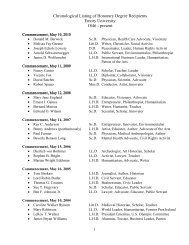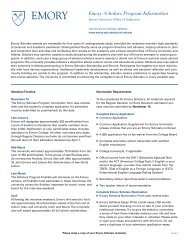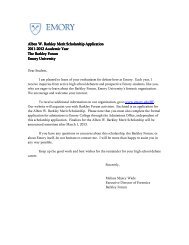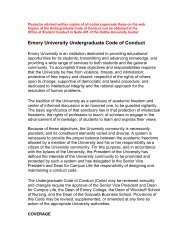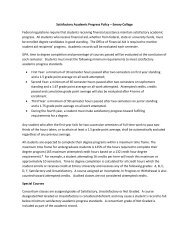DOSY Experiments - Emory University
DOSY Experiments - Emory University
DOSY Experiments - Emory University
Create successful ePaper yourself
Turn your PDF publications into a flip-book with our unique Google optimized e-Paper software.
awm<br />
nugcal_[1-5]<br />
0 selects absolute value experiment<br />
1 selects phase sensitive experiment<br />
a 5-membered parameter array summarizing the results of the<br />
calibration of non-uniform field gradients. Created by the<br />
Doneshot_nugmap sequence and then copied to the corresponding<br />
probe file<br />
probe_ stores the probe name used to acquire the <strong>DOSY</strong> experiment<br />
NOTE: Select the transmitter offset tof to be on-resonance on the HDO signal.<br />
The parameters for the heating gradients (gt4, gzlvl4) are calculated in the sequence. They<br />
cannot be set directly.<br />
The calibration is typically done by measuring 1 H profiles using the standard doped 1%<br />
H2O/99%D2O sample; the temperature dependence of diffusion coefficient for this sample can be<br />
estimated by interpolation from values in the literature.<br />
To set up the Doneshot_nugmap gradient mapping experiment, do the following:<br />
1. Calibrate the probe temperature using one of the standard samples.<br />
2. Insert the doped 1% H2O/99% D2O sample into the magnet.<br />
3. Regulate the probe (VT) temperature and note the (calibrated) sample temperature.<br />
4. Optimize the lock parameters, tune the probe and shim the sample.<br />
5. Ensure that the correct probe has been selected in VnmrJ by clicking on the Probe<br />
button on the Hardware Bar and selecting the appropriate probe file.<br />
6. Call the Doneshot_nugcal macro from the command line.<br />
7. This will set up the parameters for the Doneshot_nugmap sequence that allows the<br />
measurement of a set of diffusion-weighted profiles for characterizing the gradient nonuniformity.<br />
Select the transmitter offset tof to be on-resonance on the HDO signal.<br />
Review the parameters from the Acquire-Defaults and/or Acquire-Pulse Sequence<br />
panels, as shown in Figure 1 below.<br />
8. Click Acquire to start the acquisition.<br />
14






